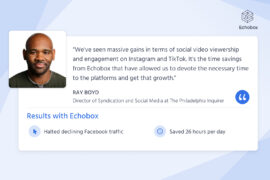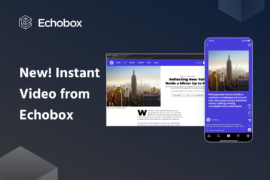The benefits of email newsletters are well known: increased subscriptions, decreased churn, collecting first party data, no social media algorithms to battle against, a direct line of communication with readers to name just a few.
Indeed, what sets email apart from channels like social media is its ability to build stronger relationships between your brand and your audience.
Broadly speaking we can think of these relationships in three different stages:
- Awareness
- Engagement
- Loyalty
So how do you nurture these relationships? How do you develop these three important stages of the audience lifecycle? Here are six key principles for building stronger audience relationships using your newsletters.
1. Streamline your subscription (and unsubscribe) process
Awareness doesn’t stop at the moment someone discovers your newsletter. Instead, think of awareness as every touchpoint up to someone opening your newsletter. If you have multiple email newsletters, awareness can encompass how visible those are to someone. How likely are they to broaden their search for other material of yours? And once they’ve found what they want, how likely are they to actually follow through and subscribe?
Making it easy to subscribe (and indeed, to unsubscribe) and removing as many barriers as possible to your newsletter obviously makes it more likely that people follow through, sign up and invite you into their inbox.
But making it easy to unsubscribe is also surprisingly important. For one, if your email solution charges fees that scale with the number of contacts you have, making sure you retain only those subscribers who regularly or even semi-regularly open your emails can help to keep costs down and improve ROI.
Viewed in this way, making it simple to unsubscribe is one of the most effective audience management techniques you can employ.
From an audience’s perspective, an easy unsubscribe process helps to retain the goodwill that you may have built up and you could perhaps leverage in the future. Someone may decide that at that moment your newsletter is not for them, but this doesn’t necessarily mean that they will not return in the future, perhaps to another of your newsletters. Forcing subscribers to go through a complex or difficult to find unsubscribe process can damage their experience of your brand and greatly reduce the chance that they will want to return to you.
In the end, keeping your subscription and unsubscription processes simple is an effective way to build trust with your audience and make their lives easier. They’ll thank you for it.
2. Keep your deliverability score high
Another reason why it’s critical to make unsubscribing simple is the risk you run if people can’t easily do it. In those cases where someone wants to unsubscribe and can’t be bothered to navigate a byzantine unsubscribe process, you run the risk that they’ll take the path of least resistance and mark your emails as spam. This could end up harming your deliverability, making it less likely that your future emails land in someone’s inbox and seriously reducing awareness when your newsletters arrive.
Ultimately, allowing subscribers to feel as though they retain a level of control keeps trust and therefore deliverability high, contributing to healthy relationships in the awareness stage and beyond. A double opt-in process, for example, which requires confirmation from a subscriber after they first sign up for a newsletter, means you’re less likely to be mistaken for spam as subscribers have had another chance to make sure that they want to hear from you. The corollary is that you end up with more engaged subscribers.
3. Cross-promote your content to increase awareness
Once you’ve effectively developed trust with your audience you can capitalize on this with broader awareness initiatives.
Cross-promoting your content is one simple but effective method that can be done a number of ways such as:
- Leveraging high-engagement introductory emails to display different newsletters
- Using the body of your email to link to other newsletters
- Proactively sending a one-off sample of other newsletters
Each of these can be effective in their own right, and with testing you can find out which option is right for your audience.
4. Remain consistent to increase your open rates
Once you’ve made sure that people are aware of your newsletters, the next step in creating a strong relationship with your audience is to ensure that they engage with your content and assimilate your email into their daily routine. Opens are important for email newsletters for the simple fact that everything follows from there — you can’t click on links in an email you haven’t opened. Moreover, open rates also have an impact on your deliverability, with ESPs much more likely to judge emails with low open rates as spam.
But establishing accurate open rates is a complicated business. Since the introduction of Apple’s iOS 16, open rates from Apple Mail have been distorted by a new privacy feature that essentially pre-opens emails. The intent was to help filter out spam, but a side effect has been to artificially inflate open rates with businesses seeing double digit increases almost overnight. This has meant that some businesses have changed KPIs to deprioritize open rates, placing their focus on metrics like click rate or subscriber growth rates instead.
Despite this, email opens are nonetheless vital, even if it’s not the metric that you choose to measure the success of your newsletter strategy. And to increase email opens, consistency is key. We covered recently how keeping your sender name consistent can help you to avoid a serious drop in open rates. In that study, we partnered with three brands to analyze the effect of changing email sender names, and the results indicate that it can be detrimental. The results demonstrated the power of consistency to engender trust, and that once trust is damaged, it’s very difficult to build again.
And trust can transfer into habit, embedding your newsletter into people’s daily lives by offering great content at regular and predictable times.
5. Optimize send times to boost engagement
The timing of your email is key. Each business will have a theory on when the best time to send emails is. For time sensitive emails such as morning briefings, the send window can be fairly restricted — between the hours of 7 AM and 11 AM, say — but where there is no such sensitivity, the potential send window can be extremely wide.
Businesses with sufficient resources may have spent the time digging into the details, finding out when, in general, people are opening their emails. But this is at best a very broad-brush calculation. Let’s say that your data shows that 40% of your audience opens your emails between 12 PM and 2 PM. This still leaves significant room for further specificity whilst not accounting for the 60% of people that open your emails at other times during the day.
This is important because inboxes are busy places. Get the timing of your email wrong and it could be buried under an avalanche of other emails, never to be seen again. In the above example, sending your email at 1 PM might still mean that a chunk of that 40% who check their email closer to 12 PM miss yours, whilst still leaving an hour’s worth of emails to mount up for those who check later. And this is to say nothing of the 60% who don’t check in this time period at all.
Here, AI technology is the single most effective tool to personalize send times on a per person basis and ensure a maximized open rate.
6. Stay relevant and agile with new campaigns
Loyalty: After spending so much time growing your audience and making sure that they engage with your content, you want to keep them. Competition for inbox space is intense, so the true test of the relationship that you have built with your readers is if that bond endures and you’re able to remain top of mind.
Creating new, timely campaigns can help remind your subscribers of the value that you bring to them and further root your content into their daily routines. What’s more, new campaigns needn’t be long term commitments. Remaining agile and thoughtful in your newsletters strategy has enormous benefits.
Covering topical events as they happen (major sporting competitions, public holidays etc.) in your own unique way allows you to capture the interest of “passing traffic” — those people who may not ordinarily have stumbled upon your content — as well as giving your existing subscribers even more for their subscription.
Beyond that, showing consideration to your audience can separate your business from your peers. Take Black Friday. Most of us are inundated with emails for all manner of deals and it can get to the point where all of these emails can become overwhelming. Sending your subscribers the option to opt out of Black Friday promotions should they wish can be an effective personal touch, letting your subscribers know that they are valued as more than just a source of revenue.
Cultivate relationships with automation
The relationship that you build with your subscribers starts even before you send them an email. In fact, your relationship spans the entire subscription life-cycle from the moment someone first thinks about signing up to your newsletters.
As we’ve seen above, there are lots of different ways your newsletters can help you grow this relationship and increase the likelihood that it endures. But with so many elements to develop, the time requirements it places on businesses can be onerous. Using an AI-powered solution means that you can take advantage of all of these optimizations without spending hours tinkering with your newsletters.
Echobox provides businesses an array of intelligently automated features such as timing and template optimization, smart content ordering and streamlined subscription workflows, as well as the possibility to automatically generate new bespoke newsletters in a matter of seconds, with each newsletter tailored to your audience.
Get in touch with us today and see how Echobox could help to improve your newsletter strategy and build effective relationships with your subscribers.




